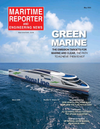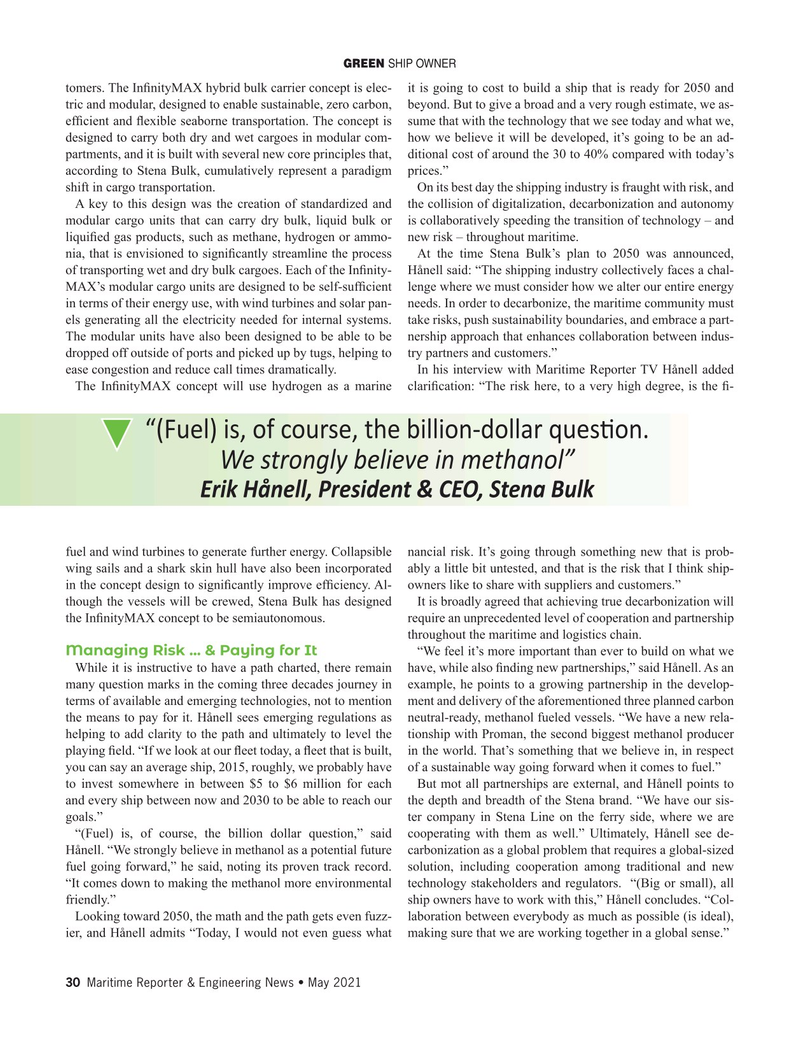
Page 30: of Maritime Reporter Magazine (May 2021)
Green Ship Technologies
Read this page in Pdf, Flash or Html5 edition of May 2021 Maritime Reporter Magazine
GREEN SHIP OWNER tomers. The In? nityMAX hybrid bulk carrier concept is elec- it is going to cost to build a ship that is ready for 2050 and tric and modular, designed to enable sustainable, zero carbon, beyond. But to give a broad and a very rough estimate, we as- ef? cient and ? exible seaborne transportation. The concept is sume that with the technology that we see today and what we, designed to carry both dry and wet cargoes in modular com- how we believe it will be developed, it’s going to be an ad- partments, and it is built with several new core principles that, ditional cost of around the 30 to 40% compared with today’s according to Stena Bulk, cumulatively represent a paradigm prices.” shift in cargo transportation. On its best day the shipping industry is fraught with risk, and
A key to this design was the creation of standardized and the collision of digitalization, decarbonization and autonomy modular cargo units that can carry dry bulk, liquid bulk or is collaboratively speeding the transition of technology – and liqui? ed gas products, such as methane, hydrogen or ammo- new risk – throughout maritime.
nia, that is envisioned to signi? cantly streamline the process At the time Stena Bulk’s plan to 2050 was announced, of transporting wet and dry bulk cargoes. Each of the In? nity- Hånell said: “The shipping industry collectively faces a chal-
MAX’s modular cargo units are designed to be self-suf? cient lenge where we must consider how we alter our entire energy in terms of their energy use, with wind turbines and solar pan- needs. In order to decarbonize, the maritime community must els generating all the electricity needed for internal systems. take risks, push sustainability boundaries, and embrace a part-
The modular units have also been designed to be able to be nership approach that enhances collaboration between indus- dropped off outside of ports and picked up by tugs, helping to try partners and customers.” ease congestion and reduce call times dramatically. In his interview with Maritime Reporter TV Hånell added
The In? nityMAX concept will use hydrogen as a marine clari? cation: “The risk here, to a very high degree, is the ? - “(Fuel) is, of course, the billion-dollar quest on.
We strongly believe in methanol”
Erik Hånell, President & CEO, Stena Bulk fuel and wind turbines to generate further energy. Collapsible nancial risk. It’s going through something new that is prob- wing sails and a shark skin hull have also been incorporated ably a little bit untested, and that is the risk that I think ship- in the concept design to signi? cantly improve ef? ciency. Al- owners like to share with suppliers and customers.” though the vessels will be crewed, Stena Bulk has designed It is broadly agreed that achieving true decarbonization will the In? nityMAX concept to be semiautonomous. require an unprecedented level of cooperation and partnership throughout the maritime and logistics chain.
Managing Risk ... & Paying for It “We feel it’s more important than ever to build on what we
While it is instructive to have a path charted, there remain have, while also ? nding new partnerships,” said Hånell. As an many question marks in the coming three decades journey in example, he points to a growing partnership in the develop- terms of available and emerging technologies, not to mention ment and delivery of the aforementioned three planned carbon the means to pay for it. Hånell sees emerging regulations as neutral-ready, methanol fueled vessels. “We have a new rela- helping to add clarity to the path and ultimately to level the tionship with Proman, the second biggest methanol producer playing ? eld. “If we look at our ? eet today, a ? eet that is built, in the world. That’s something that we believe in, in respect you can say an average ship, 2015, roughly, we probably have of a sustainable way going forward when it comes to fuel.” to invest somewhere in between $5 to $6 million for each But mot all partnerships are external, and Hånell points to and every ship between now and 2030 to be able to reach our the depth and breadth of the Stena brand. “We have our sis- goals.” ter company in Stena Line on the ferry side, where we are “(Fuel) is, of course, the billion dollar question,” said cooperating with them as well.” Ultimately, Hånell see de-
Hånell. “We strongly believe in methanol as a potential future carbonization as a global problem that requires a global-sized fuel going forward,” he said, noting its proven track record. solution, including cooperation among traditional and new “It comes down to making the methanol more environmental technology stakeholders and regulators. “(Big or small), all friendly.” ship owners have to work with this,” Hånell concludes. “Col-
Looking toward 2050, the math and the path gets even fuzz- laboration between everybody as much as possible (is ideal), ier, and Hånell admits “Today, I would not even guess what making sure that we are working together in a global sense.” 30 Maritime Reporter & Engineering News • May 2021
MR #5 (18-33).indd 30 5/6/2021 5:29:27 PM

 29
29

 31
31
